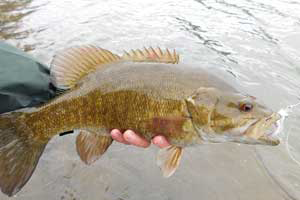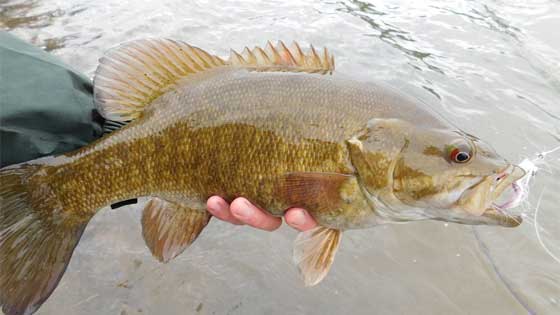Smallmouth Bass Features and Size

Smallmouth Bass mature much quicker in lakes with very low levels of turbidity and that contain diverse ecosystems and rocky bottoms.
Description
- This is a robust fish with a laterally compressed body, a large, long, head with dark bars which radiate back from the eyes
- It has a long, blunt snout with a slightly longer lower jaw and two joined dorsal fins that appear as one
- The protruding, lower jaw extends beyond the middle of the eye
- They have red eyes, brownish body, two connected or notched dorsal fins, one spiny and one soft
- The back and top of the head is brown, golden brown through olive to green
- The sides are lighter than the back, more golden with golden flecks on most scales and marked by 8 to 15 pronounced to vague, thin vertical bars
- The underside is cream to milk-white
- Pectoral fins are clear and the others are opaque, dark to amber with some black on rays, spines or membranes
- It’s body color is variable with size, condition and habitat
- In clear water they are darker with pronounced, contrasting markings
- In turbid water, they are lighter with vague markings
Smallmouth bass have the ability to change color to suit their surroundings (note: The color changes are minor). They prefer a lower light environment and this is when they’re most active. They’ll avoid direct sunlight, preferring the twilight hours of dawn and dusk.
Size
Smallmouth Bass reach adulthood between 2 to 4 years of age.
At 10 years of age, smallmouths reach about 20 inches long and a weight of 5 to 6 pounds.
The maximum life expectancy is 15 years, although the rate of maturation is directly dependent on the body of water. The further north we go, the slower the growth rate and the smaller the maximum size. Generally speaking, northern smallmouth bass live longer than their southern counterparts.
- Your best chance at catching a large smallmouth bass is by fishing the remote lakes of Canada and the central United States.
The Smallmouth is often mistaken for a largemouth bass. The major difference is the size of their jaw. Their jaw ends just under the eye, while the largemouth’s jaw goes further back.
Record for Smallmouth Bass
The average smallmouths come in at less than 5 pounds, on average. 5 pounds can be considered a trophy bass in many northern lakes and rivers.
The smallmouth bass record was set at Dale Hollow Lake in 1955 with a catch weighing in at almost 12 pounds.



